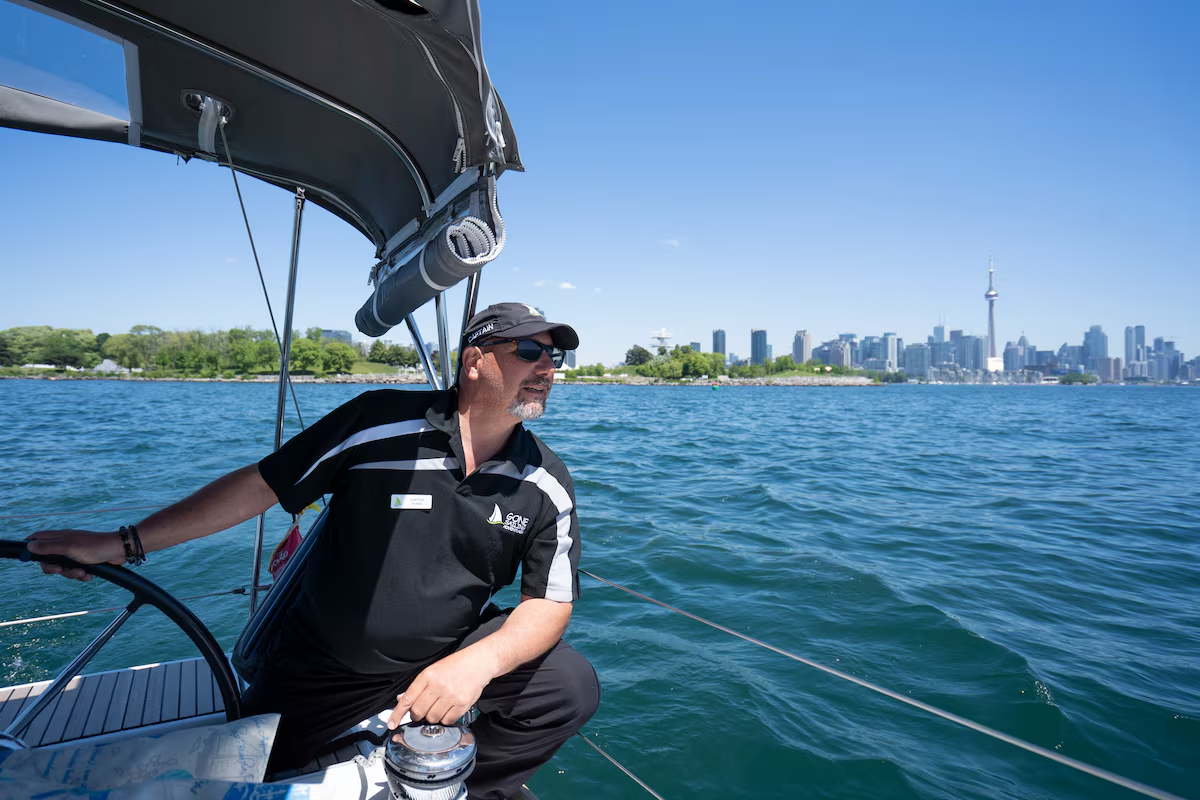
Have you ever had that feeling of being somewhere new, maybe visiting a new country, or even just starting a new job, where you realize that you’re in a totally different culture?
You don’t know the routines or customs and everyone’s either speaking a different language or speaking your language, but with new terms and inside jokes you don’t know. The excitement of trying something new can be mixed with apprehension. What if you don’t know what to do? What if you say or do the wrong thing? Believe it or not, more than a few people have had that feeling stepping onto a boat for the first time. Sailors tend to have their own traditions and routines (and we certainly have a unique lingo). If you’ve just taken up sailing, or you’ve been invited on the water for the first time, don’t worry. With a few tips and some fun new sailing terms, you’ll fit in like an old pro in no time.
Nautical language has a long and storied history, with many sailing terms that can completely confuse the newcomer. Here are some of the basics so you don’t sound totally lost out there.
BASIC SAILING TERMS FOR THE NEW SAILOR
BOW AND STERN
Boats don’t have a “front and back,” they have a bow and stern. The bow (pronounced like “Ow!” with a “B” in front) is the front of the boat and the stern is the back.
PORT AND STARBOARD
It’s not left and right on a boat, it’s port and starboard. This is because left and right are relative, depending on whether you’re facing the bow or the stern. Assuming you’re facing the bow, the port side is on your left and the starboard is on your right. The easy way to remember is that “port” and “left” both have four letters. So, port is left and starboard is right.
LINES
Ropes on a sailboat aren’t ropes, they’re lines (with some exception). So if you’re asked to “hold the line,” you’ll know you’re just holding on to a rope — simple, right?
The exceptions? There are a few: “Bolt Rope”, “Foot Rope”, “Tiller Rope”, “Bell Rope”, and others depending on the vessel.
Now you know what to do if you need to grab the bow line on the port side!
A few other sailing terms that are helpful to know:
The Head
The bathroom on the boat is called “the head.” The story goes that in the glory days of sail in the 19th century, the toilet was always placed at the front, or “head” of the boat, because the wind would carry away the stench. Not so glorious if you ask me, but that’s how we got the term.
Mast and Boom
On a sailboat, the mast is the main pole that sticks up out of the boat, to which the sail is attached. The boom is the horizontal beam that comes out towards the stern, the one that can swing when the boat comes about. Speaking of which . . .
Coming About/Tacking
This is when you make a quick turn to catch the wind on the other side of the sails. Since the wind is rarely going the exact desired direction, sailors take a “tack,” a series of turns to catch the wind and move in toward the intended destination. Think of it like climbing switchbacks on a steep hill. Coming about means you’re making a turn to go towards your destination in the opposite direction, like taking the next turn on the trail.
Heeling
The force of the wind, when you’re tacking, often pushes the boat so that it leans at an angle toward the water (you’ve probably seen boats do this and thought that they were going to tip over, but they didn’t). This is called “heeling”, and it used to terrify me as a child. It’s normal though, and nothing to worry about. Larger boats are built with strong keels, the piece that sticks straight down under the boat to counterbalance the effects of heeling.
Now that you know some of the terms, let’s talk about some basic etiquette. This is especially for you if you’re a passenger, but it’s helpful even if you’re heading out on your own vessel.
BASIC SAILING ETIQUETTE (OR HOW TO GET INVITED BACK ONTO SOMEONE’S BOAT)
Listen to your captain. The captain of the boat is responsible for the safety and enjoyment of the people on board. Don’t be afraid to ask if you’re not sure about where to be or what to do and make sure to pay attention if they give you any ground rules like wearing a life jacket, where you can and can’t go, and where to find safety equipment.
Keep your head up. If you ask me, there’s no better sound than the moment when the engine is cut on a sailboat and you hear the wind fill the sails and the waves lap the hull (the bottom part of the boat). But that’s also the moment, especially on smaller vessels, where you need to make sure you’re alert. The boat can heel over quite quickly, ropes may be moving, and the boom could swing around suddenly. It’s important to pay attention and be aware of your surroundings.
Be ready to help. One of the fun things about sailing is there’s always something to do and new things to learn. You may be asked to help with the lines or even steer the boat. Enjoy it! Ask questions! Be ready to pitch in if you’re asked. And be ready to move. On a smaller boat, you may be asked to shift seats from time to time to help keep the weight balanced.
There’s lots more to learn, but part of the fun of boating, like trying anything new, is getting a hang of the culture and lingo as you experience it. These rules and sailing terms should help get you started. So go out there, grab a line, and have fun!




If you have any questions or need assistance, please don't hesitate to contact us:
WhatsApp us
When considering chartering a yacht in Canada, we know you have many options. Some of these options look super exciting and at ridiculously great prices. Recent trends in the industry have opened the door for many unqualified individuals to purchase boats and offer charter services to the unsuspecting public. It’s easy to create a website and even easier to just list a boat on sites such as Facebook Marketplace, Kijiji, Getmyboat, Boat Setter and many others.
Unfortunately, many of these operators are NOT licensed, insured or qualified to accept your trust on the water.
In order to be licensed and insured a number of items MUST be in place. Listed are just a few.
Over the last few years there have been a number of deaths and even more accidents resulting from these types of operators. Be safe and know who you are getting on a boat with. All licensed operators should willingly display their credentials, and most are members of the Passenger & Commercial Vessel Association (PCVA).